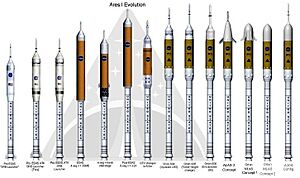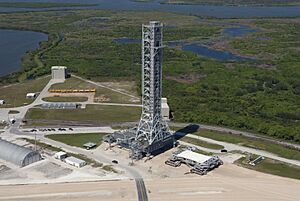Ares I facts for kids
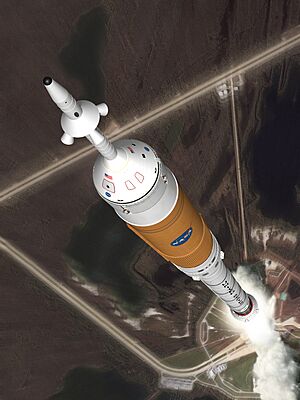
Ares I launch
|
|
| Function | Human-rated orbital launch vehicle |
|---|---|
| Manufacturer | Alliant Techsystems (Stage I) Boeing (Stage II) |
| Country of origin | United States |
| Project cost | at least US$ 6 billion |
| Size | |
| Height | 94 meters (308 ft) |
| Diameter | 5.5 meters (18 ft) |
| Stages | 2 |
| Capacity | |
| Payload to LEO | 25,400 kg (56,000 lb) |
| Associated rockets | |
| Family | Followed by Liberty, would have complemented the cargo Ares V |
| Launch history | |
| Status | Cancelled as of October 2010 |
| Launch sites | would have launched from Kennedy Space Center, LC-39B |
| Total launches | 1 (prototype) |
| First flight | October 2009 (Prototype) |
| First stage | |
| Engines | 1 Solid |
| Thrust | 15,000 kN (3,400,000 lbf) |
| Burn time | ≈150 seconds |
| Fuel | Solid |
| Second stage | |
| Engines | 1 J-2X |
| Thrust | 1,308 kN (294,000 lbf) |
| Burn time | ≈800 seconds |
| Fuel | LH2 / LOX |
The Ares I was a special rocket that NASA was building. It was designed to carry astronauts into space. This rocket was part of a bigger plan called the Constellation program.
The name "Ares" comes from the Greek god of war, Ares. He is also known as the Roman god Mars. Before it was called Ares I, it was known as the "Crew Launch Vehicle" (CLV).
NASA wanted Ares I to launch the Orion spacecraft. Orion was meant to carry humans on space missions after the Space Shuttle retired. Ares I would have worked with a larger rocket, the Ares V. The Ares V was designed to carry heavy cargo, not people.
NASA chose the Ares designs because they thought they would be safe and reliable. They also believed they would be cost-effective. However, the Constellation program, including Ares I, was stopped in 2010. This happened when the U.S. president at the time, Barack Obama, signed a new law. Later, in 2011, NASA announced a new rocket system. This new system, called the Space Launch System, would be used for human exploration beyond Earth.
How the Ares I Rocket Was Developed
Early Ideas for Space Travel
In 1995, a company called Lockheed Martin studied new ways to travel in space. They looked at different rocket ideas. Some of these ideas were very similar to what Ares I later became.
These early designs used a first stage made of solid rocket boosters. On top of that, they had a second stage with liquid fuel. They even thought about using engines like the J-2S or Space Shuttle Main Engines (SSMEs) for the second stage.
Designing the Exploration System
In 2004, President George W. Bush announced a new plan for space exploration. NASA then asked companies for ideas for a new Crew Exploration Vehicle. But the new NASA administrator, Michael Griffin, changed these plans.
In 2005, NASA started a new study called the Exploration Systems Architecture Study. This study had important goals:
- To figure out what was needed for rockets that would carry people and cargo to the Moon and Mars.
- To see how the new crew vehicle could take astronauts to the International Space Station.
- To create a plan for exploring the Moon with both humans and robots.
- To find important technologies needed for these exploration systems.
NASA decided to use a design based on the Space Shuttle for Ares I. At first, the crew rocket would have a four-segment solid rocket booster for its first stage. It would also use a simplified Space Shuttle Main Engine for the second stage.
Later tests showed that the Orion spacecraft would be too heavy. So, in 2006, NASA made some changes. They decided to make the Orion spacecraft a little smaller. They also added a fifth segment to the solid-rocket first stage. Instead of the SSME, they chose the J-2X engine for the second stage. This engine was based on the Apollo program's J-2 engine.
The study concluded that Ares I would be safer and cheaper than other rockets. These other rockets were called Evolved Expendable Launch Vehicles (EELVs).
Ares I's Role in the Constellation Program
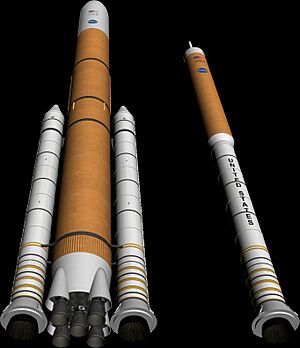
Ares I was a key part of the Constellation program. Its job was to launch the crew. Unlike the Space Shuttle, which launched both crew and cargo on one rocket, Constellation had two separate rockets. Ares I was for people, and Ares V was for cargo. This allowed each rocket to be designed specifically for its job.
The Ares I rocket was built to launch the Orion Multi-Purpose Crew Vehicle. Orion was a capsule, like the ones used in the Apollo program. It was meant to take astronauts to the International Space Station, the Moon, and even Mars. Ares I could also carry some supplies to orbit. This included supplies for the space station or a future base on the Moon.
Companies That Built Ares I
NASA chose Alliant Techsystems to build the first stage of Ares I. This company also built the Space Shuttle's solid rocket boosters. On July 16, 2007, NASA announced that Rocketdyne would build the J-2X engine for the second stage.
Then, on December 12, 2007, NASA picked Boeing. Boeing was responsible for putting the electronic systems, called avionics, into the Ares I rocket. Boeing also got the contract to build the Ares I Upper Stage. This part of the rocket was to be built at the Michoud Assembly Facility. This factory was used to build parts for the Space Shuttle and the Saturn V rocket.
The J-2X Engines
The J-2X engine was designed and built by Rocketdyne. Each engine would have cost about $20–25 million. This was less than half the cost of the more complex RS-25 engine, which cost around $55 million.
Unlike the Space Shuttle Main Engine, the J-2X was made to start in space or near-vacuum. This ability to "air-start" was very important. The original J-2 engine, used on the Saturn V rocket, also had this feature. It helped push the Apollo spacecraft towards the Moon.
Design Review and Changes
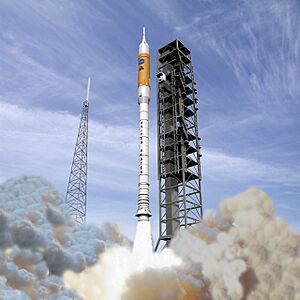
On January 4, 2007, NASA announced that Ares I had finished its system requirements review. This was the first major step in designing the rocket. It made sure that Ares I met all the needs for the Constellation Program.
During this review, NASA also announced a change to the fuel tanks. Instead of separate tanks for liquid hydrogen (LH2) and liquid oxygen (LOX), they would use a "common bulkhead." This means the tanks would share a wall, like on the Saturn V rocket. This change saved a lot of weight. It also made the design simpler.
Schedule and Costs
NASA finished the Ares I design review in January 2007. The plan was to continue designing until late 2009. Testing would happen until 2012. By July 2009, they hoped to start building the first rockets for launch in June 2011. The first human launch was planned for no later than 2014. This was four years after the Space Shuttle was set to retire.
However, the Ares I project faced delays. These were due to money problems and unexpected technical issues. The time between the Space Shuttle's retirement and Ares I's first flight grew longer. The total cost to develop Ares I also increased. It went from $28 billion in 2006 to over $40 billion in 2009. The test flight, Ares I-X, cost $445 million.
An independent group, the Augustine Commission, looked at the project in 2009. They found that Ares I would likely not launch with a crew until 2017–2019. This was due to the technical and money problems. They also estimated that each Ares I flight would cost almost $1 billion.
Later, in March 2010, more analysis showed that if Ares I flew only once a year, it would cost $1 billion or more per flight. But if it flew many times a year, the cost per launch could drop to about $138 million. NASA administrator Charlie Bolden said in 2010 that Ares I would cost $4–4.5 billion a year. He also said each flight would cost $1.6 billion.
In 2011, two companies, Alliant Techsystems and Astrium, suggested a new rocket. They wanted to combine the Ares I first stage with the second stage of the Ariane 5 rocket. They called this new rocket Liberty.
Why Ares I Was Cancelled
On February 1, 2010, President Barack Obama suggested stopping the Constellation program. He later announced changes to this plan. In October 2010, a new law was signed that officially cancelled the Constellation program. This included the Ares I rocket.
Ares I Design
Ares I could carry about 25,000 kilograms (25 tons) into space. This was similar to other rockets like the Delta IV and Atlas V. The NASA team that chose the Ares I design believed it was almost twice as safe as rockets based on Atlas or Delta IV.
First Stage
The first stage of Ares I was a powerful, reusable solid fuel rocket. It was based on the Space Shuttle Solid Rocket Booster (SRB). The Space Shuttle SRB had four segments. Ares I's first stage had a fifth segment. This extra segment gave Ares I more power.
Other changes were made too. The points where the Space Shuttle's external tank attached were removed. A new part, called a forward adapter, was added to connect to the liquid-fueled second stage. This adapter had small solid motors to help the stages separate during launch. The design of the solid fuel inside also changed, along with the insulation and lining.
Upper Stage
The upper stage of Ares I was based on the Space Shuttle's External Tank. It was also similar to the S-IVB stage of the Saturn V rocket. This stage used a single J-2X rocket engine. The engine was powered by liquid hydrogen (LH2) and liquid oxygen (LOX).
The J-2X engine was an improved version of the original J-2 engine from the Apollo program. It had more thrust and fewer parts. NASA gave Rocketdyne the contract to build these J-2X engines in 2007. Rocketdyne had also built the original J-2 engines for the Apollo program.
Even though the J-2X engine was based on an old design, the upper stage itself was completely new. At first, it was planned to have separate fuel and oxidizer tanks. These would be joined by an "intertank" structure. They would also be covered with foam insulation to keep the fuel cold.
Later, they decided to use a "common bulkhead" between the tanks. This was like the design used on the S-II and S-IVB stages of the Saturn V. This change saved weight. The saved weight was then used to carry more fuel. The upper stage could hold about 135,000 kilograms (297,900 pounds) of propellant.
See also
- Ares IV, a proposed heavy-lift variant of Ares I and V combined.
- DIRECT, shuttle-derived launcher proposed as alternative to Ares I and Ares V.
- Liberty (rocket), a proposed medium-lift rocket like the Ares I, a SDLV using an SRB-derivative first stage
- Omega, ATK's proposed new rocket based on SDLV SRB-derived first and second stages and Aerojet Rocketdyne RL10 third stage
- List of Constellation missions
- Boilerplate (spaceflight)


